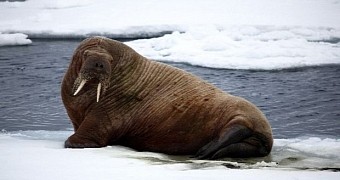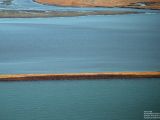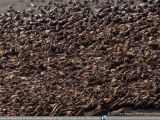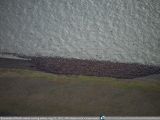An aerial view of Alaska's Arctic coast obtained earlier this month by researchers with the Bureau of Ocean Energy Management and the National Oceanic and Atmospheric Administration shows thousands of walruses gathered near the village of Point Lay.
The photo, available in the gallery below, was taken on September 2. Other images obtained by wildlife photographer Gary Braasch and taken in late August offer a closer view of the animals, about 35,000 of them.
What are so many walruses doing in Alaska?
Like polar bears, walruses depend on the Arctic's sea ice coverage to survive. In late summer and early fall, walruses populating the waters off the north coast of Alaska and Chukotka, Russia, set up camp on sea ice to rest and be close to their food sources.
In recent years, however, the Arctic has been slowly losing its sea ice, all because of climate change and global warming. With not enough sea ice to serve as their home, walruses are moving on land.
“As Arctic sea ice reaches the fourth lowest extent on record, stunning photos from Alaska’s Arctic coast again show tens of thousands of walruses gathered on shore near the community of Point Lay.”
“In recent years there has been no sea ice over the walruses’ preferred shallow feeding areas. Thousands have been forced ashore, where they must expend far more energy to find food,” explains green group the World Wildlife Fund.
Walruses need ice to survive, specialists say
As noted by the World Wildlife Fund, walruses forced to retreat on land rather than on chunks of ice in the open sea have to put more effort into finding food. This is because their usual buffets are farther away from them than they are accustomed.
Besides, wildlife researchers say having so many walruses gathered on just one beach is a threat to the creatures. The slightest disturbance could cause a stampede resulting in the death of hundreds of animals that would simply be trampled to death by their own.
Furthermore, having walruses gather on land rather than on sea ice means polar bears must too work harder to get to them and hunt them, supposing that they manage to find them, to begin with.
The World Wildlife Fund says that, to save the walruses, the polar bears and other Arctic dwellers, we must strive to ditch fossil fuels and switch to using renewable energy alone by 2050 at the latest.

 14 DAY TRIAL //
14 DAY TRIAL // 



